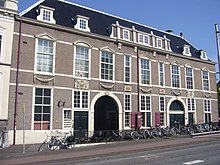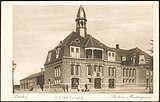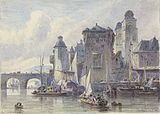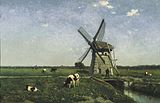Royal Academy of Art, The Hague
 Royal Academy of Art at the Prinsessegracht 4 in The Hague since 1937. | |
| Established | 1682 |
|---|---|
Academic affiliation | University of the Arts in The Hague |
| President | Marieke Schoenmakers |
| Students | 850 |
| Location | , |
| Website | www.kabk.nl |
 | |
The Royal Academy of Art (Dutch: Koninklijke Academie van Beeldende Kunsten, KABK) is a renowned art academy in The Hague. Succeeding the Haagsche Teeken-Academie (part of the Confrerie Pictura), the academy was founded on 29 September 1682, making it the oldest in the Netherlands and one of the oldest in the world.[1]
It has been training ground for a number of significant artists of the Hague School and it was part of the art movement of Dutch Impressionism and was also in the immediate vicinity of the II. Golden Age of Dutch painting. However, in the 19th century the training for a long time was still strongly oriented towards the classic curriculum. At the end of the 19th century this academy had opened to Modernism, too.
History


The Royal Academy of Art The Hague, was founded on September 29, 1682 by Willem Doudijns, Theodor van der Schuer, Daniel Mijtens the Younger, Robert Duval and Augustinus Terwesten as the Haagsche Teeken-Academie (engl.: "The Hague Drawing Academy".) In the evening there were drawings classes and on Saturday the society debated about art.[2][3]
In the 18th century the Hague Academy was a thriving institution. The end of the 18th century were difficult times due to the absence of any financial support. The low point was around 1800, when the academy was working with less than ten students.[1][4]
Under William I of the Netherlands finally support returned and the old and important institute grew. In 1821 the drawing education was combined with the newly established School of Civil Engineering.[5] After being housed in the Korenbeurs and Boterwaag in 1839, a new neoclassical building was designed by city architect Zeger Reyers (1790-1857), located at the Prinsessegracht.
In the 19th century the famous artists Johannes Bosboom, Isaac Israels, Willem Maris, Jan Hendrik Weissenbruch and George Hendrik Breitner were trained here. In 1937 on the site of the ancient temple completed a new academy building designed by J.H. Plantenga (1891–c. 1945), J.W.E. Buijs en J.B. Lürsen.
In 1990 the Royal Academy merged with the Royal Conservatory of The Hague into the "School of Visual Arts, Music and Dance". In 2010 the Dutch government elevated the joint institutions to "University of the Arts in The Hague". The two do also still go by their original names as well, to underline their individual identities.
The academy every two years awards the Gerrit Noordzij Prize initial designs.
Buildings


After the year of 1821, she received more importance again, as the School voor Burgerlijke Bouwkunde was connected to it. Now she moved in the house of the Korenbeurs (Grain Exchange).[6] This small building was very important for the future of this school.
Later they moved to the Boterwaag (weighing house for butter). There wasn't enough light for the painting classes. Finally in the year 1839 the Academy got their own house at the Prinsessegracht - it was built by Zeger Reyers in the architectural style of the Neoclassicism .
In the 20th-century the classes do grow and more place was needed. Thus from 1934-1937 the academy got a new building at Prinsessegracht 4. The new building has been built in the style of the Bauhaus.[7]
Hague School

At the end of the 19th century witnessed the Hague art scene flourished, which was also very well known abroad as Hague School. Many well-known artists like Breitner, the brothers Maris (Jacob Maris and Matthijs Maris) and Bosboom were trained in the academy. In the first half of the 20th century the academy has played a pioneering role in the Netherlands, too.
Under Bauhaus- influence arose the new departments of
- graphic design,
- advertising,
- photography,
- design and
- furniture design.
In that time the teachers of the avant-garde like Gerrit Kiljan (1881-1961), Paul Schuitema (1897-1973), Paul Citroen (1896-1983) and Cor Alon (1892-1967) dominated. The Academy expanded its curriculum as one of the first Dutch schools by teaching in the field of industrial design.
In 1938 a new building erected on the site of the old house. The design was by the architectural firm Plantenga, Buijs & Lürsen. In 2000 a general overhaul was carried out. For this project was the architect Van Mourik Vermeulen responsible - even the complex was enlarged.
Gallery of some famous members of the academy in the 19th century
-
Karel de Bazel: Station Heerenpoort in Leiden, 1925.
-
Johannes Bosboom (1827/1891): Koblenz - Rijksmuseum Amsterdam.
-
Jacob Maris (etwa 1886): Harbour of a town in the Netherlands - Rijksmuseum Amsterdam.
-
Jan Hendrik Weissenbruch (1873): Landscape with windmill near Schiedam - Museum Boijmans van Beuningen.
Modern times
In 1990 the Academy merged with the Royal Conservatory to the Hogeschool van Beeldende Kunsten, Muziek en Dans (Academy of Fine Arts, Music and Dance). At the same time a more intensive cooperation with the University of Leiden has begun. - In the Netherlands, the first formalized cooperation between a university and an art school was initiated. It allowed students to hear within one semester at two colleges — so at Leiden University and at the Royal Academy in The Hague.
In 2001 a partnership with Leiden University was started, which resulted in the Academy of Creative and Performing Arts (ACPA); this was the first formalised collaboration between a university and an arts institute in the Netherlands. ACPA offers the opportunity to follow a PhD programme resulting in a PhD for a combination of an artwork and a dissertation. The KC, KABK and Leiden University offer double degree programmes, carry out research programmes and develop new methods of study. Electives at the universities are open for all students.
The KABK’s focus on new technologies and new media has resulted in state-of-the-art workshops, studios and departments like ArtScience, Interactive/Media/Design and most recently, Non-Linear Narrative.
Faculty and emeriti faculty
Notable alumni
- Johannes Bosboom
- Isaac Israëls
- George Hendrik Breitner
- Charles Leickert
- Tom Manders
- Jan Mankes
- Willem Maris
- Jacob Maris
- Matthijs Maris
- Charles Bolsius
- Marcel van Eeden
- Johanna van Eybergen
- Alida Jantina Pott
- Dolly Rudeman
- Peter Alma
- Kees Andrea
- Jacob Jan van der Maaten
- Pat Andrea
- Joost Baljeu
- Marius Bauer
- Johfra
- Joop Beljon
- Loek Bos
- Rie Cramer
- Jan Cremer
- Toon Dupuis
- Pierre Tetar van Elven
- Willem van Genk
- Carli Hermès
- Karel Klinkenberg
- Gerrit Noordzij
- Ootje Oxenaar
- Rahi Rezvani
- Matthijs Röling
- Toer van Schayk
- Yamuna Forzani
References
- ^ a b "History". KABK. Retrieved 17 December 2014.
- ^ Plantenga, J.H., De academie van 's Gravenhage 1682-1937, Den Haag 1938
- ^ Joop Beljon (1982). 300 jaar Koninklijke Academie van Beeldende Kunsten 's-Gravenhage 1682-1982: een beknopt overzicht. p. 16.
- ^ These problems were the result of the continental blockade of England.
- ^ Beljon (1982, p. 41)
- ^ The former Corn Exchange House is now a cultural center of the city of The Hague.
- ^ The flow of the Bauhaus at Dessau had great influence on the facade design of many public buildings in Europe.
External links
- Art schools in the Netherlands
- Royal Academy of Art, The Hague
- 1682 establishments in the Dutch Republic
- Organisations based in The Hague
- Organisations based in the Netherlands with royal patronage
- Educational institutions established in the 1680s
- Education in South Holland
- Buildings and structures in The Hague




